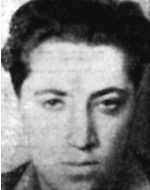Menachem, the son of Tova (Tauba) and Arieh Leib, was born on December 23, 1929 in Warsaw, the capital of Poland. He grew up in Warsaw. Warsaw, the capital of Polish Jewry, was also an important center of world Jewry in general. On the eve of World War II, there were about 375,000 Jews who enjoyed cultural, educational, religious and political momentum, established welfare institutions, and published newspapers and books. Many of them were engaged in crafts and industry, trade and finance. Others earned their living from free professions. The severe economic crisis of the 1930s also affected Poland’s agriculture, exacerbating anti-Semitic tendencies and repressing the Jews, who were considered to be key players in economic life. The Jews of Warsaw suffered an anti-Jewish economic boycott that led to a rapid impoverishment and a growing pogrom. Warsaw was subjected to a German attack from the beginning of World War II and surrendered three weeks later, on September 28, 1939. 90,000 refugees were brought to the city and conditions of life worsened. The Jews were an immediate victim of vulnerability and discrimination. Their property was stolen, they were stripped of their jobs and marked. A walled ghetto was established in the city, where Jews and many refugees were transferred. The deportation of the Jews to extermination camps began in the summer of 1942 and was carried out in several waves. In the winter of 1943, when the pace of the deportations increased, the young people began preparing themselves for the beginning of the revolt. The Warsaw Ghetto Uprising, which broke out on the eve of the Passover holiday in 1943, lasted for several weeks during which the fighters stopped the Germans and killed them, and at the end of the revolt the last Aktion was carried out and the ghetto was liquidated. His father in various workshops in Warsaw under German occupation, and against his will he acquired the profession of the frameworks, and Menachem and his parents were deported in 1943 to the Majdanek extermination camp near the city of Lublin, where the child was forced to watch the execution of the parents. And others – from starvation, exhaustion, illness, and beating.In the autumn of 1943 Menahem was transferred to the Budzyn labor camp Near the town of Krasnik, where about 3,000 Jews were forced to work in German military factories and the German aircraft industry, and were sent to the Mauthausen camp in Austria, And then sent to the Dachau camp where he was found by soldiers of the American army in April 1945. Menachem survived the inferno after being forced to watch the execution of his parents. Immediately after his release, he joined the Nocham (United Pioneering Youth) youth movement, which was composed of young people from different parties, who wished to immigrate to Eretz Israel and live in the Land of Israel. The ship, which was organized by the Mossad Le’Aliyah Bet of the Hagana, sailed from the port of La Ciotat on the French Riviera with 1,252 illegal immigrants from Eastern Europe and Western Europe and members of youth movements, and the British followed the ship from the moment it set sail, Using water jets and tear gas, firing from pistols and hitting clubs. “Latrun” was towed to the port of Haifa, and in early November 1946 After seven months Menachem was allowed to immigrate to Israel, and when he arrived, he joined Kibbutz Afikim in the Jordan Valley and immersed himself in training and agricultural work, and was a cultured white man. His life before and after the Holocaust, but in moments of risingThe wind was a slight smile on his lips as he softly hummed the sung song, so his friends knew that he shared with them their experiences of joy. Everyone loved him for his delicacy. With affection and tenderness they would call him “Zibele,” a nickname that accompanied him in his short journey. Immediately after the United Nations General Assembly decided on November 29 to partition the country, a few months after his arrival in Israel, Menahem volunteered for the defense forces. He was recruited from the Jordan Valley in Battalion 12 (“Barak”) of the Golani Brigade, the No. 1 Brigade in the Hagana, and took part in the battles of the brigade. Menachem fulfilled his tasks with dedication and without fear. A few days before his departure, he says in a letter to a friend: “Everything is fine with me … I am in a small Arab town not far from Afikim, and the day before yesterday, the best of my friends fell … I got freedom to attend the funeral, but who knows when? “At the moment, there is quiet … Although on several occasions the hands swelled with guns, this does not happen often …” On May 15, 1948, a Syrian brigade armed with armored force and cannons invaded and advanced rapidly through the Jordan Valley. The Syrians took control of several outposts in the area, but were stopped by the Israeli forces, including Golani fighters, Palmach fighters, and settlers from the Jordan Valley On May 18, 1948, the Syrians launched a renewed and powerful attack on a plant Aided by artillery and tanks. Many defenders were injured. At first the town of Tzemach fell, and finally the police station, and the Israeli fighters were forced to retreat under heavy fire to Kibbutz Degania Aleph. Many people fell in the retreat, including Menahem. He was nineteen years old when he fell. The bodies of the fallen were found only after the reoccupation of a plant three days later. Menachem was brought to rest in a mass grave in the military cemetery in Degania Aleph on May 21, 1948. This hero is a “last scion”.
